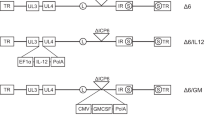Summary.
The present study demonstrates that a clonal derivative (HF10) of HSV-1 strain HF effectively treated disseminated peritoneal neoplasm in an immunocompetent animal model and that all of survived mice acquired resistance to rechallenge with tumor cells. The survival time of mice treated with HF10 was longer than that of mice treated with hrR3, indicating that the oncolytic effect of HF10 was more potent than that of hrR3 in this animal model. HF10 induces syncytia formation in vitro, whereas hrR3 forms rounded CPE. The sequential administration of HF10 gave a long term survival of more than 90 days after tumor injection, with no signs of disease, in 8 of the 9 treated mice. The results suggest that treatment of disseminated peritoneal tumor with HF10 induces a specific antitumor immune response. Genomic structure determination showed that HF10 has a deletion of 3.9-kilobase pair (kbp) in the right end of UL and UL/IRL junction, resulting in the loss of UL 56 expression. A 2.3 kbp deletion and extensive rearrangement were also observed in the left end of the genome.
Similar content being viewed by others
Author information
Authors and Affiliations
Additional information
Received August 9, 2002; accepted October 11, 2002
Rights and permissions
About this article
Cite this article
Takakuwa, H., Goshima, F., Nozawa, N. et al. Oncolytic viral therapy using a spontaneously generated herpes simplex virus type 1 variant for disseminated peritoneal tumor in immunocompetent mice. Arch Virol 148, 813–825 (2003). https://doi.org/10.1007/s00705-002-0944-x
Issue Date:
DOI: https://doi.org/10.1007/s00705-002-0944-x




